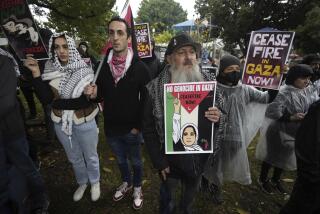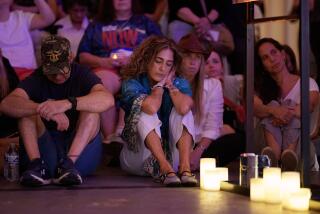PERSPECTIVE ON THE HEBRON MASSACRE : A Killer and His Beliefs Were U.S. Imports : West Bank settlers come disproportionately from America; many are imbued in the radicalism of Brooklyn’s own Jewish Defense League.
- Share via
It is noteworthy that it was an American immigrant to Israel who committed a horrible act of violence Friday in the massacre of Palestinians in Hebron.
What has been the effect of American immigrants on politics in Israel and specifically on relations between Israelis and Palestinians? The impact has both impeded and advanced the peace process.
Settlers on the West Bank tend to be disproportionately drawn from American immigrants to Israel, though the numbers are not overwhelming. About 1% of all Israelis are recent American immigrants, but 10% of the settlers in the occupied territories come from the United States.
More to the point of the Hebron massacre, however, the radical settlers tend to come from the United States. Dr. Baruch Goldstein, who carried out the mass shooting, was an adherent of the extremist Kach movement, which believes that Arabs should be forcibly expelled from the area of “Greater Israel” that they envision as stretching from the Mediterranean to the Jordan River.
Kach was founded by the late Rabbi Meir Kahane, who emigrated to Israel after starting the Jewish Defense League in Brooklyn, New York. The JDL carried out intentionally provocative actions against blacks in New York and portrayed black-Jewish relations as an inevitable clash of enemies. Kahane’s actions won him the fervent loyalty of a small band of committed extremists, as well as the staunch opposition of leaders in both communities who wanted to work together for better relations and the furtherance of mutual agendas.
Kach in Israel is essentially the wholesale importation of the JDL to the Holy Land, except that racism against blacks was replaced by unmitigated hostility against Arabs. Running on an anti-Arab platform, Kahane won a seat in the Israeli Knesset. So unacceptable was his ideology, however, that Israeli parties of the Left and Right joined together to ban Kach from elections. Kahane was later assassinated, but his followers carry on his virulently anti-Arab message.
Kach forms the core of the Hebron settler community, the most hard-line in the West Bank. Residents have announced that they will resist with violence any territorial compromise the Israeli government might negotiate.
Understanding all this, it is not surprising that Goldstein, imbued with racist ideology, committed the mass murder in Hebron. Even if he decided alone to shoot up a crowded mosque during an important service, he could only have believed from his Kach experience that there was nothing wrong with killing Arabs.
Fortunately, the importation of JDL and Kach ideology to Israel is not the only contribution that Americans have made to Israeli public life.
American immigrants were also among the founders and leaders of Israel’s Peace Now movement. They supported peace initiatives during the years the Likud Government opposed dialogue with the PLO and have led the country in advocacy of the current peace process. They have mounted massive demonstrations on behalf of peace and have conducted research projects to expose the extent of settler activity and its enormous cost to Israeli society. They have also initiated dialogues with Palestinians that have furthered the peace negotiations. Many of these immigrants are veterans of civil-rights and social-justice movements in the United States and have brought their values to the movement for peace in Israel.
The difference between the two kinds of immigrants was starkly illustrated when Peace Now called for the removal of Jewish settlers--many of them Kach supporters--from the heart of Hebron after the massacre.
U.S. culture has greatly influenced both mainstream peace advocates and their most violent opponents. Some claim that American Jews can have no real impact on the peace process. The facts, however, show that our influence is profound.
More to Read
Sign up for Essential California
The most important California stories and recommendations in your inbox every morning.
You may occasionally receive promotional content from the Los Angeles Times.










